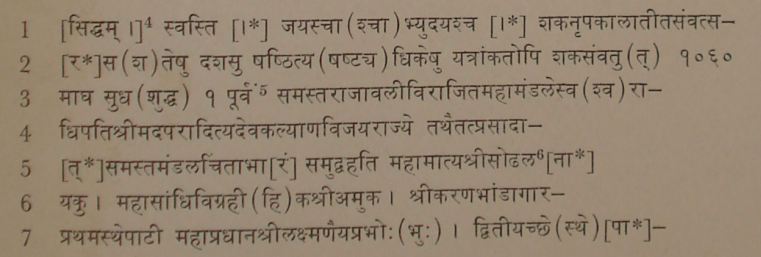|
The Indian Analyst
|
North Indian Inscriptions |
INSCRIPTIONS OF THE SILAHARAS OF NORTH KONKAN
sāṁdhivigrahika, line 6). So the two verticals of dhā are joined by a short horizontal stroke to distinguish it from vā (see Mahāpradhāna, line 7). The language in incorrect Sanskrit. The whole record is in prose. The only orthographical peculiarity to be noticed is the use of the dental for the palatal sybilant (see satēshu, line 2). ..The inscription refers itself to the reign of the Mahāmaṇḍalēśvaradhipati, the illustrious Aparādityadēva, who, from the date noticed below, is evidently the first Śilāhāra king of that name, who ruled in North Koṅkaṇ. The record is dated the first tithi of the bright fortnight of Māgha in the expired Śaka year 1060, expressed both in words and figures. This date corresponds to the 3rd January A.D. 1139[1]. It does not admit of verification in the absence of the necessary details. In lines 14-15, there is a reference to a solar eclipse without any mention of the Śaka year. The solar eclipse which occurred before, nearest to the aforementioned date, is that on the amāvāsya of Kārttika in the expired Śaka year 1059 (15th November A.D. 1137).[2] .. The object of the inscription to record three grants made by Aparāditya –one of a mango filed in (the village) Nāguma for his own spiritual welfare, the second of an orchard for that of his mother Līlādēvī, and the third, also of an orchard, in the village Chaṁḍijā on the occasion of a solar eclipse. The first two grants were made to the royal Parishad, evidently of Chaṁḍijā, and the third to certain astrologers of the place Vādu at the holy place of Muru. The present inscription mentions the following officers : (1) the Mahāmātya Sōḍhala Nāyaka, (2) the Mahāsāndhivigrahika Amuka and (3 and 4) the Treasury officers−the Senior one, Mahāpradhāna Lakshmaṇaprabhu, and the Junior one, Amuka. The letter two officers are also mentioned in the preceding Cintra stone inscription which had been incised just in the preceding year, Śaka 1059. There is the usual imprecation at the end.
.. As for the localities mentioned in the present grant, the village Nāguma is modern Nāgaon, two miles south-west of Uraṇ, and Chāṁḍijā is Chānjē, about two miles to the east of Nāgaon. Both the villages are included in the Panvel tālukā of the Kolābā District. The holy place of Muru, where the third grant was made is probably identical with the Marutkshētra (modern Muruḍ), mentioned in the Panhāḷe plates (No. 23). Vādu, where the astrologers who received the gift were residing, may be Vandelī in the Muruḍ Mahāl of the Kolābā District. Text[3]
[1] Sanskalia and Upadhyaya give the 13th January A.D.1138 as the Christian equivalent of the date, but it
corresponds to Śaka 1059 expired, not to Śaka 1060.
|
|||||||||||||||||||||||||||||||||||||||||||||||||||||||||||||||||||||||||||||||||||||||||||||||||||||||||||||||||||||
| > |
|
>
|








